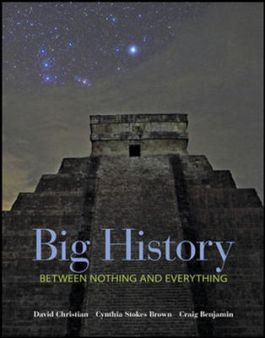EBOOK Big History: Between Nothing and Everything 1e
- Note: the eBook does not include access to Connect
- Access the eBook anytime, anywhere: online or offline
- Create notes, flashcards and make annotations while you study
- Full searchable content: quickly find the answers you are looking for
Introduction: What Is Big History and How Do We Study It?
Seeing the Big Picture
Seeing the Whole of the Past
What Is Big History?
The Basic Shape of the Story: Increasing Complexity
A Framework: Eight Major Thresholds of Big History
A Note on Chronological Systems and Dates
Summary
Chapter 1 The First Three Thresholds: The Universe, Stars, and New Chemical Elements
Seeing the Big Picture
Threshold 1: Big Bang Cosmology and the Origin of the Universe
Threshold 2: The Origin of Galaxies and Stars
Threshold 3: The Creation of New Chemical Elements
Summary
Chapter 2 The Fourth Threshold: The Emergence of the Sun, the Solar System, and the Earth
Threshold 4: The Emergence of the Sun and Solar System
The Early Earth—a Short History
Shaping of Earth’s Surface
Summary
Chapter 3 The Fifth Threshold: The Emergence of Life
Seeing the Big Picture
How Life Changes through Natural Selection
Threshold 5: The Emergence of Life on Earth
A Brief History of Life on Earth
Summary
Chapter 4 The Sixth Threshold: Hominines, Humans, and the Paleolithic Era
Seeing the Big Picture
Hominine Evolution: 8 Million to 200,000 Years Ago
Threshold 6: The Appearance of Homo sapiens
The Paleolithic Era: 200,000 to 10,000 Years Ago
Summary
Chapter 5 The Seventh Threshold: Origins of Agriculture and the Early Agrarian Era
Seeing the Big Picture
Threshold 7: Agriculture
Explaining the Agricultural Revolution
The Early Agrarian Era
The Emergence of Consensual Power
Summary
Chapter 6 Mini-Threshold: The Appearance of Cities, States, and Agrarian Civilizations
Seeing the Big Picture
Defining Cities, States, and Agrarian Civilizations
The Buildup of Resources and Collective Learning
Uruk, the First City, in Sumer, the First State
Cities and States in Other Regions
Summary
Chapter 7 Afro-Eurasia during the Era of Agrarian Civilizations: Part 1
Seeing the Big Picture
Introduction to the Agrarian Later Era
The Era of Agrarian Civilizations
First Trend: The Expansion, Power, and Effectiveness of Agrarian Civilizations and Their Administrations
Summary
Chapter 8 Afro-Eurasia during the Era of Agrarian Civilizations: Part 2
Seeing the Big Picture
Second Trend: The Establishment of Significant Networks of Exchange among Agrarian Civilizations of Afro-Eurasia
Third Trend: Evolving Social and Gender Complexity
Fourth Trend: The Generally Slow Pace of Change and Growth
Summary
Chapter 9 Other World Zones during the Era of Agrarian Civilizations
Seeing the Big Picture
Agrarian Civilizations of the American Zone
The Pacific and Australasian World Zones
Chapter 10 On the Brink of a Threshold: Toward the Modern Revolution
Seeing the Big Picture
The Approach of the Modern Revolution
Why Rates of Innovation Increased: Drivers of Innovation
The World in 1000 CE
The Postclassical Malthusian Cycle: Before 1350 CE
The Early Modern Malthusian Cycle: 1350 to 1700 CE
The World in 1700 CE
Summary
Chapter 11 Crossing the Eighth Threshold: Breakthrough to Modernity
Seeing the Big Picture
Threshold 8: The Modern World/Anthropocene
Social, Agricultural, and Industrial Revolution in Great Britain
The Spread of the Industrial Revolution
Political Revolution: The Rise of the Modern State
The Emergence of Two Worlds—Developed and Developing
Other Consequences of the Industrial Revolution
Summary
Chapter 12 The Anthropocene: Globalization, Growth, and Sustainability
Seeing the Big Picture
Introduction
Part 1: Political and Military Changes
Part 2: Growth—More Humans Consuming More
Part 3: The Impact of Growth and Industrialization on Lifeways and Societies
Part 4: The Anthropocene and the Human Impact on the Biosphere—Is Growth Sustainable?
Summary
Chapter 13 The History of the Future
Seeing the Big Picture
Future 1: The Near Future
Future 2: The Next Few Thousand Years
Future 3: The Remote Future
Conclusion—The End of the Story: Humans in the Cosmos
Summary
Glossary
Credits
Index
Big History: Between Nothing and Everything surveys the past not just of humanity or even of planet Earth but of the entire universe. In reading this book, instructors and students will retrace a voyage that began 13.7 billion years ago with the Big Bang and the appearance of the universe. Big history incorporates findings from cosmology earth and life sciences and human history and assembles them into a single universal historical narrative of our universe and of our place within it.
The first edition of Big History: Between Nothing and Everything is written by the pioneers of the field and presents a framework for learning about anything and everything. It encourages students to think critically about our cumulative history and the future of the world through a variety of lenses.
Instructors and students can now access their course content through the Connect digital learning platform by purchasing either standalone Connect access or a bundle of print and Connect access. McGraw-Hill Connect® is a subscription-based learning service accessible online through your personal computer or tablet. Choose this option if your instructor will require Connect to be used in the course. Your subscription to Connect includes the following:
- SmartBook® - an adaptive digital version of the course textbook that personalizes your reading experience based on how well you are learning the content.
- Access to your instructor’s homework assignments quizzes syllabus notes reminders and other important files for the course.
- Progress dashboards that quickly show how you are performing on your assignments and tips for improvement.
- The option to purchase (for a small fee) a print version of the book. This binder-ready loose-leaf version includes free shipping.Complete system requirements to use Connect can be found here: http://www.mheducation.com/highered/platforms/connect/training-support-students.html

